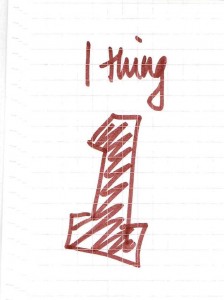Faster presentation Prep!
So it takes you days to prepare a presentation. But today you have only an hour. Here are some important ways to approach it.
Know your one thing
“If you take one thing away take this… “. What is that one thing for your presentation?
Avoid the curse of knowledge (knowing so much we can’t express ourselves simply).
Know your one thing.
Write it down.
You have 3 minutes to do this. Use a timer!
Stand up to prepare
Sitting may be the new smoking. But sitting also keeps you in old patterns. Stand up. Use a whiteboard or a flipchart and markers. Stand at a bench and use crayons.
Map out the three big ideas that come from your one thing. Don’t go into detail. There isn’t time.
Give yourself just 3 minutes for this.
Draw three pictures
Now if you could only use three pictures, what would they be?
Draw them on three pieces of paper.
Even if they are just stick figures.
If worst comes to worst you can draw them for your audience, or scan them in for your PowerPoint.

You can see my three with this article. It’s not about winning art prizes.
You have 5 minutes for this section.
Answer the four important questions in a rough draft
You know your one thing.
You know the three sub-points of that one thing.
You have three pictures.
Now write a really sketchy first draft. Still standing at a whiteboard, flipchart or bench.
Make it big picture, like you are fast forwarding at speed through a movie you know well, looking for the best bits.
To write the draft, answer these four important questions in this order. They become the spine around which you hang your prepare preparation. More on the Four important questions here.
Firstly why?
Why should I do what you are asking, or listen to what you are saying?
If I were to do a why for this article it could include reasons like you should prepare faster because it saves you time, impresses your boss, advances your career, and gives you more time to spend on more important things.
Why should people listen to what you are talking about?
You have 3 minutes for this
Secondly, what?
What do you want them to do? Or what you want them to understand? What are the principles? This is often the one thing and its three big ideas.
For this article the what is
- get your one thing
- decide your three things
- draw your three pictures
- write a rough draft to answer the four important questions
- pull it together.
You’ve already got the core of this, so you get 2 minutes to do it (you won’t need them!).
Thirdly, how?
Okay, so now they know what you want the next question is how can they do it?
What are the steps, what do they do first, what practical application can they do?
For the how of this article read the information under each of the headings above.
If there is an exercise of a practical questions they need to answer, this is where it goes.
You have 5 minutes to write down the bones of the how
What next
Finally the fourth question you need to ask is what next?
Now that you’ve told me what you want to tell me, and how to do it, now I can do it, or know what to do, what vistas open up for me?
The what next for this article is that once you are proficient at preparing training and presentations faster you’ll discover you are also faster at assembling key ideas and cutting to the chase in other contexts. You will run meetings more effectively, prepare reports more quickly and delegate more effectively.
Give yourself 5 minutes for the What next.
Now take a moment
So far you’ve used 26 minutes. You have 34 to go.
In the next 4 minutes take a walk around the floor or make a cup of tea (don’t check email, you’ll get lost in there!). The reason you do this is to give your left, analytical brain time to relax. Then your right, associative, meaning-making brain can kick in. If you’ve ever had a great idea while working out or in the shower, then you understand: this is a version of that. It will give you time to think of the missing (or unnecessary) components.
For more information, read about Eureka moments here
Finally, pull it together
In the final 30 minutes pull it together.
After the presentation review what parts of this process worked for you and what you would change. But remember, you don’t have to spend hours preparing!









